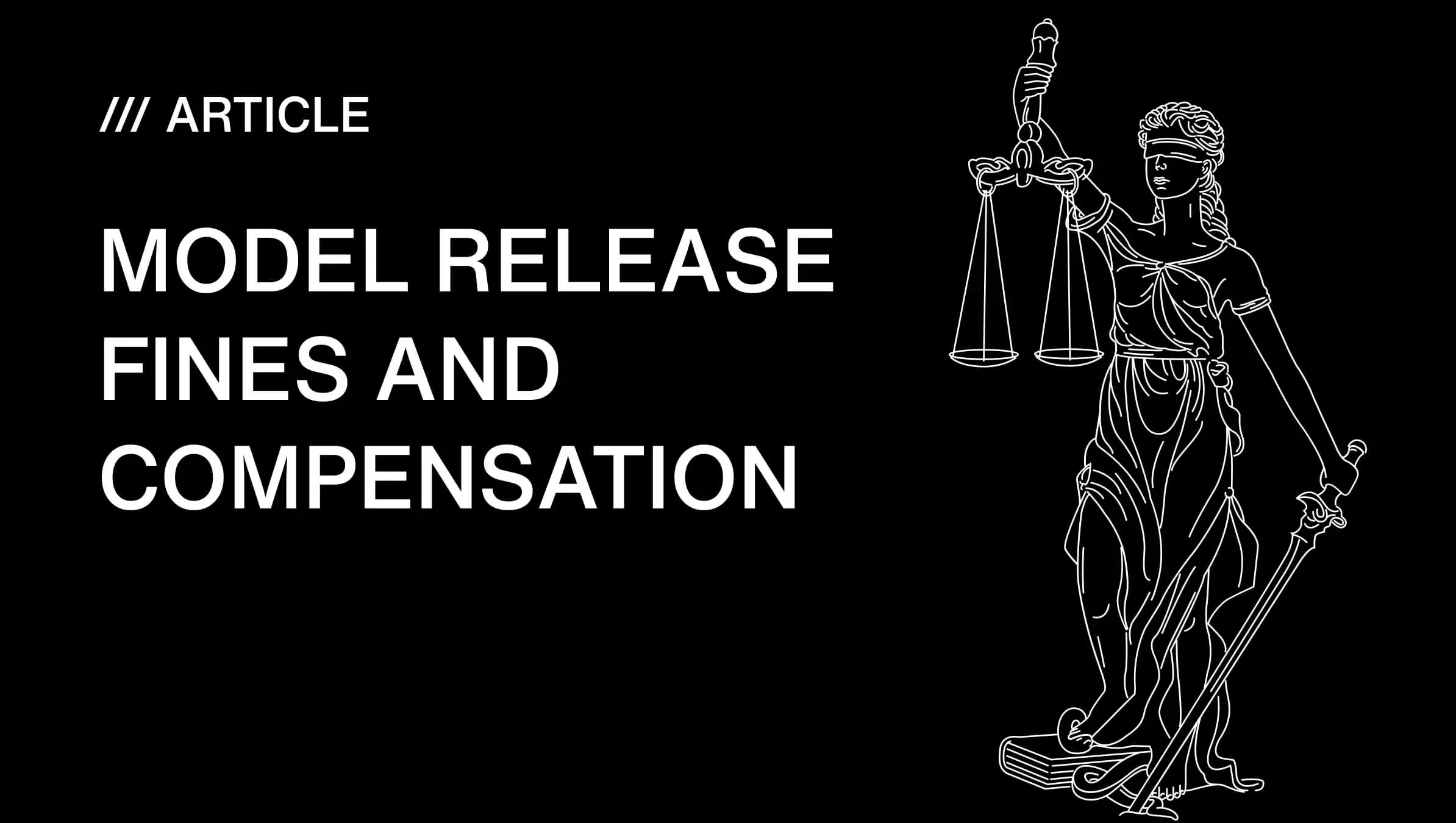Why Model Releases Are Essential for Commercial Photography
If you photograph people — models, clients, influencers, or even employees — you’ve probably heard someone say,
“Don’t forget the model release.”
Most photographers smile, nod, and then skip right past it. Until something goes terribly wrong. Here’s the truth nobody talks about at workshops:
A missing or sloppy model release can cost you $15,000… $150,000… or, in worst cases, millions.
A model release isn’t just a boring legal form. It’s your seatbelt as a photographer. Everything feels fine until suddenly it doesn’t — until a model changes careers, until a brand reuses a photo in a bigger campaign, or until someone finds their face on a product they never approved. And when that happens?
It’s lawsuit season
This guide breaks down real, documented cases of model release fines and image rights compensation — including payouts from $15K to $16 million — and explains how to protect yourself legally every time you pick up the camera.
Why Model Releases Matter in Commercial Photography
A model release is essentially a license to use a person’s image. It defines:
- • How their image can be used (commercial, editorial, internal)
- • Where it can appear (web, print, billboards, packaging)
- • How long the permission lasts
- • Which campaigns it covers
- • What rights the client receives (transferable? exclusive?)
Without clear, written consent, any commercial use becomes a legal risk — and one that usually lands on the photographer.
Commercial use goes far beyond ads
It includes:
- • Social media posts by brands
- • Marketing emails
- • Website hero images
- • Paid ads (Facebook, Google, TikTok)
- • Product packaging
- • Print brochures
- • E-commerce listings
- • Billboards and banners
If an image helps a business sell something, it’s commercial. No release = legal trouble waiting to happen.
Why Photographers Get Sued Over Model Releases
After reviewing hundreds of cases, these four patterns show up repeatedly:
1. Using photos beyond the release terms
The release says “social media,” but the client uses the image on:
- • product packaging
- • magazine ads
- • national billboards
Courts overwhelmingly side with the model.
2. Using a model’s image with no release at all
TFP portraits, event photos, casual portraits — if later used commercially, the model can demand:
- • removal
- • compensation
- • damages
And they almost always win.
3. Implying endorsement without permission
Even subtle cases — a face beside a slogan — count as: Right of Publicity Violations. Some of the most expensive lawsuits in photography come from this.
4. Continuing to use employee photos after they leave
Especially in the EU, where GDPR requires ongoing consent. Using ex-staff in marketing = immediate violation.
Real Cases of Model Release Fines and Compensation
These are not myths or rumors. These are real, legally documented cases — with source references integrated into the text.
Case #1: $150,000 for Exceeding the Model’s Release
A model agreed to limited usage. The brand expanded the campaign — more ads, more formats, broader distribution. She sued and won $150,000, discussed in the image-rights damages overview by Mark Roesler’s legal team.
Key Insight
Always define scope clearly: platforms, territories, campaign types, and duration.
Case #2: $100,000 for Commercializing Nude Images Without Consent
A publisher used an artistic nude portrait in a paid advertisement with no commercial release. The model was awarded $100,000, referenced in the Roesler damages archive.
Main Lesson
Sensitive or intimate images require the strictest release language — no exceptions.
Case #3: Cher Wins Over $325,000 for Implied Endorsement
A magazine made it look like Cher endorsed their publication. The court awarded over $325,000, as noted in the Mark Roesler damages archive.
What You Should Learn
Endorsement cases fall under “right of publicity” — extremely high-risk and expensive.
Case #4: $25,000 Statutory Damages for Using a Single Photo
A real estate website used one unauthorized image. Traffic didn’t matter. Views didn’t matter. The court awarded $25,000, analyzed in the attorney breakdown of the $25K infringement demand case.
Core Lesson
Unauthorized use is costly. Unauthorized commercial use is disastrous.
Case #5: €10,000 for Using Ex-Employee Photos (Germany)
A company continued using photos of an ex-employee in marketing materials. Courts ruled it violated GDPR and personality rights. Compensation: €10,000, explained in the FGvW legal analysis.
Legal Insight
Employee photos require explicit, revocable, time-limited consent.
Case #6: £1,953 + Legal Fees for Unauthorized Use (UK)
A business used a Getty image without licensing. The settlement was £1,953.31, but legal costs multiplied this significantly, according to Pinsent Masons’ report. Documented in the Pinsent Masons report.
Key Insight
Even small violations can trigger large expenses when legal teams get involved.
Case #7: France — Compensation for Taking a Photo Without Consent
A celebrity was photographed on a private beach. French courts ruled that even capturing the image without permission violated her rights. Detailed in UGGC’s image-rights analysis.
Main Insight
France enforces some of the strictest image-rights laws in the world.
Case #8: $15,000 Demand for a Campaign Shot Without a Release
A photographer named “Alex” shot a commercial campaign without securing a model release. When the model discovered her image was used commercially, her lawyer demanded $15,000. Covered in Legal GPS’s contract resources.
Practical Insight
Small-budget shoots can turn into five-figure legal threats instantly.
Case #9: Vanessa Bryant Awarded $16 Million for Crash-Site Image Misuse
Officials shared graphic crash-site photos after the helicopter incident involving Kobe Bryant. A jury awarded $16 million to Vanessa Bryant, detailed in Axios’s reporting. Reported in Axios’s trial coverage and the settlement update.
Core Lesson
Unauthorized photography — even without commercial intent — can lead to enormous penalties.
How Photographers Can Protect Themselves
After reviewing these cases, one truth stands out: Most model-release problems come from unclear agreements or misuse of images.
Here’s how to avoid 99% of legal trouble:
1. Always collect a detailed model release
Never rely on:
- • verbal permission
- • DMs
- • informal agreements
A proper release should outline:
- • usage
- • platforms
- • territories
- • campaign types
- • duration
- • revocation rules
2. Don’t reuse images for new campaigns
If the client expands usage, you need:
- • a new release, or
- • a release that explicitly covers future campaign rights
3. Protect sensitive content
Nude, boudoir, intimate, or vulnerable content requires:
- • clear restrictions
- • separate consent
- • additional legal protections
4. Track releases like a legal database
Store:
- • digital copies
- • usage rights
- • expiration dates
This keeps you safe from unintended violations.
Typical Fine Ranges for Model Release Violations
Based on real cases:
- • Small violations: $500–$3,000
- • Moderate violations: $5,000–$30,000
- • Severe violations: $50,000–$500,000+
- • Extreme cases: $1,000,000–$16,000,000+
One missing signature can cost more than your entire year’s income.
Conclusion
A model release isn’t just paperwork — it’s protection. One page can save you from a $15,000 demand or a $150,000 lawsuit. The cases above show exactly what happens when releases are missing, vague, or ignored. If you photograph people, make model releases a non-negotiable part of your workflow. Your financial future depends on it.





